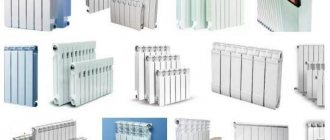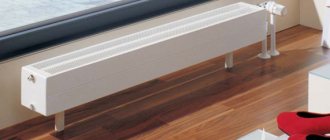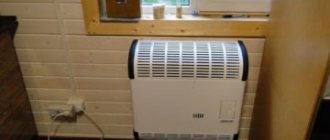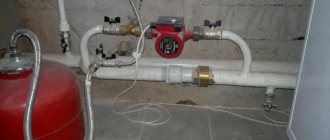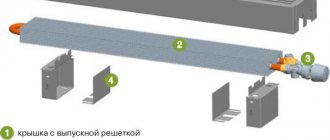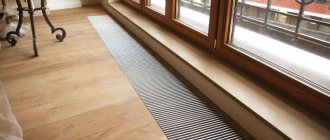Panoramic glazing of housing is a popular fashion trend in modern renovation and construction. To heat a room with such windows, standard heating devices are not suitable, so experts have developed built-in devices for hidden installation.
They are universal water in-floor heating convectors, which are distinguished by their compactness and attractive appearance. Before deciding to use innovative equipment, you need to understand its features, don’t you agree?
The article describes in detail the various types of in-floor convectors, identifies the strengths and weaknesses of such radiators, and also provides tips on their selection and installation.
Trench convectors in the interior
The modern market offers various heating equipment, which is designed to create a comfortable and cozy atmosphere in rooms for various purposes.
In-floor models are universal devices that perform heating and decorative functions. They provide the desired temperature in an apartment or office in a short period of time.
Water floor convectors are efficient devices that are installed in the floor. They are designed to quickly heat the room
A convector connected to a water heating system or power supply is a multifunctional device that perfectly performs its direct functions and serves as interior decoration. It not only plays the role of a compact, almost invisible heating equipment, but is also a stylish addition to the design of the room.
If the apartment owner has chosen devices placed in the floor structure for heating, special niches will have to be prepared during the renovation process.
Water in-floor convectors are devices that are installed under the floor covering. They will effectively heat and decorate your living space.
Built-in models are more attractive and efficient than conventional radiators. The latter heat the room using thermal radiation, and electric convectors and water models, in addition to radiation, also heat the air flow circulating through them.
Features of operation, as well as recommendations for choosing electric and water floor-type convectors are given in the articles:
- How to choose electric heating convectors: what to look for before buying + review of brands
- Water floor heating convectors: types, manufacturers, how to choose the best
Underfloor heating devices are closed on 3 sides, so regardless of their location, they transfer the majority of the heat upward. Due to the use of special insulating materials, a small part of the thermal energy is lost to the sides.
conclusions
Summarizing all of the above, I would like to draw the attention of readers to the need for the correct selection of floor convectors. And it will be correct only if the appropriate calculations have been carried out and the actual conditions of its operation have been taken into account. Thus, we reach the real thermal power of the device and design features that ensure stable operation of the system. Most of the same readers do not resort to the help of designers, but they can also choose a convector that theoretically meets average operating conditions. The result in this case depends on the accuracy of compliance with all the recommendations given above and the requirements of the manufacturer of the specific equipment.
Where are built-in heating systems used?
Floor-mounted convectors are innovative heating equipment that is distinguished by unique characteristics and stylish appearance.
They are recommended to be installed in the following cases:
- In rooms with large window openings , to eliminate the possibility of a draft in the room.
- In small rooms with a lack of free space or in those in which, according to the project design, there should be no unnecessary elements. The devices are built into the floor screed, leaving maximum space free.
- In rooms with high humidity levels, regardless of their purpose. Here their role is to provide a kind of curtain that prevents windows from fogging up.
In order not to be disappointed and avoid losing money, it is recommended to study information about the models you like before purchasing.
A properly selected heating device will definitely meet your expectations and will allow you to significantly save on energy consumption.
Types and features of equipment
The design of the electrical built-in unit is quite simple. It consists of a metal box housing, in the middle of which there is a heating element. To maximize heat transfer, it is equipped with convective fins. The top of the heater is covered with an aesthetic grille located at floor level.
In some cases, built-in convectors are installed in the window sill. This technique is practiced if in-floor heating devices are not enough to optimally heat the room
To increase the thermal power, some models are equipped with fans. They increase the speed of movement and heating of air by 75-90%. To reduce the noise generated by fans, special inserts made of porous rubber are used.
If large heating power is not required, the in-floor unit can operate with the fan turned off due to natural convection.
To achieve the optimal temperature in the room, temperature controllers and sensors are used, which are located in the middle of the metal case. Regulators can be electromechanical or electronic.
This unit controls the temperature and fan speed. Convenient “manual” control allows you to set the required parameters if necessary.
Convectors built into the floor can be equipped with a thermostat that shows the temperature, controls the process of coolant flow in the heat exchanger and the fan rotation speed
A heating device connected to a heating circuit differs from an electric one only in that instead of a heating element there is a pipe running inside it. By analogy, it is equipped with fins, the purpose of which is to increase heat transfer.
Water type floor convectors can also be equipped with fans to speed up the heating process.
Each element of an in-floor convector is made from different materials, has certain characteristics and performs its functions. Therefore, the quality and functionality of the heating device should be assessed based on the included accessories.
A thermostat is built in to regulate the temperature, and a fan is installed to increase the efficiency of the device.
Bottom line
Recently appeared on our market, these in-floor convectors have become widespread, due to their convenience and cost-effectiveness. These devices are reliable, do not spoil the appearance of the premises, and are easy to replace if necessary. The shape and size can be very different, which allows you to install them in a semicircle or at an angle. Trench convectors are especially good in humid environments, as well as where you need to create a thermal curtain.
Of course, you can do everything yourself, but in any case there are nuances, and only a specialist knows exactly at what height from the bottom of the channel to place the heat exchanger and in what place, how many fans are required. A convector instead of a battery is an excellent solution for both a private house and an apartment.
to menu
Basic requirements for the device housing
The appearance of the metal case does not play an important role, since it is located in the floor of the room. Particular attention should be paid to the quality of this element, since the reliability and durability of the heating unit depends on the indicator and its class is determined.
The metal from which the body is made plays an important role:
- For installation in damp rooms, a convector with a body made of stainless material with increased moisture resistance is suitable.
- For dry rooms, select a device with a body made of galvanized or black steel, which is coated with anti-corrosion paint, resistant to external influences.
Typically, special powder compositions are used to coat the metal body. They effectively protect metal from rust formation and external influences.
Designers recommend choosing convectors whose parts and inner walls of the housing are painted in a dark color. They are almost invisible, so they look more aesthetically pleasing
Which type of grating do you prefer?
When choosing a heating device built into the floor, pay special attention to the grille. This element has a decorative role, as it remains above the floor.
The grating can be made of the following materials:
- galvanized, stainless or ordinary steel;
- anodized aluminum;
- natural marble;
- wood - beech, ash, merbau, oak, etc.
When choosing a material, it is necessary to take into account that the system must fit harmoniously into the interior and correspond to the design of the room.
Based on their design, there are 2 types of grilles for in-floor convectors:
- rolled - grilles are more expensive and easier to use, since they can be rolled up;
- linear - must be fully raised.
The slats in roll-up grilles are located exclusively across. In a linear design, they are located across and along the heating device.
Decorative grilles are a stylish completion of an underfloor heating system. They will help hide the ventilation and heating device
The design of the grate is especially important if people will step on it from above. In this case, you need to pay attention to the appearance and materials used in manufacturing. You should check that the grille does not contain any plastic parts, which manufacturers sometimes use at the junction of the frame and slats.
To evenly distribute the load on the device, reduce noise levels and increase comfort, some manufacturers install springs at the junction of the frame and the lamella.
In conditions of increased load, it is better to choose a grille that has the same design on both sides. If it wears off, it can be turned over for further use.
Assembly of heat exchanger elements
Step 1. Bring the box indoors and open it. Before opening, pay attention to the top and bottom, otherwise there will be difficulties when removing parts of the convector. Check the contents. Inside the housing there should be a heat exchanger, adjustable legs, adjusting bolts and washers, a decorative grille, connecting, shut-off and control valves.
Unpacking the convector
Checking the completeness
Step 2. Take two valves out of the package, unscrew the connecting nuts with fittings.
ADN15
VDN115
Step 3. Screw a special thread onto the thread for sealing, the number of turns is at least 5–8.
Winding the thread
Important. The thread must be wound along the thread; while tightening the fitting, it should be tightened and not loosened. This is a very important condition; if it is not met, water leaks will certainly occur. You will have to disassemble the already installed convector and eliminate the problems.
Step 4. Hold the outlet of the heat exchanger pipe with one wrench, and with the second, screw the valve tightly into place. The valve inside has a hexagonal key hole. There is no need to apply too much effort; the thread reliably copes with its task. Use the same method to assemble the device’s faucet.
Screwing the valve
Crane assembly
Tap connection
The heat exchanger is ready. It is advisable to first test the tightness of the connections. To do this, you can connect it to the water supply using flexible hoses and open the water supply. Everything is normal - you can start installing the case.
Features of in-floor water devices
The heating element of water heating devices built into the floor is a hollow tube with pressed or welded plates. Heat transfer is carried out by coolant with antifreeze or water. Trench convectors are connected to a common water heating system using threaded pipes.
In built-in water products, the heat exchanger plays an important role. Maximum power is provided by more expensive copper and copper-aluminum heat exchangers. The latter are equipped with a copper pipe and aluminum fins.
Manufacturers also offer budget models made of stainless steel and an economy option made of galvanized steel.
The heat exchangers and inner walls of the body of most models of trench convectors are painted dark. Due to this, they are practically invisible through the decorative grille
Expensive convectors equipped with copper heat exchangers, in addition to the function of increasing the power of the device, have several disadvantages.
Disadvantages of using such models:
- Copper requires special operating conditions. It is not compatible with some metals from which coolant and grounding devices are made.
- Operating models with heat exchangers made of this metal in a central heating system can cause problems.
But they are suitable for individual heating systems where there is wiring with polymer, metal-polymer or copper pipes. It is better if the heat exchanger of the heating boiler is also made of copper.
Fittings and fittings must be chrome-plated, nickel-plated, brass or bronze.
In addition to water ones, manufacturers offer electric built-in convectors. In them, the main role is played by the heating element - the heating element. It contains plates designed to increase the area of contact of the device with air.
These devices serve as an additional source of thermal radiation in rooms where it is not possible to connect water heating.
Standard solutions for some premises
First of all, you need to decide on the area of the room that will need to be heated. For large areas of office space or shopping centers, it is necessary to install several heating devices at once, and it is advisable to provide them with forced ventilation. For extremely large areas there should be several priors. Also, based on the level of required heat transfer, you should decide which heating option is better - water or electric? The first one will be cheaper to operate, but there may be problems with quickly warming up the room. The second one will cost a pretty penny, but will ensure uniform and timely heating.
Apartment convectors and models for small offices will be less demanding in terms of installation conditions. Due to the small heating area, it is possible not to use additional fans in them, but also to use central water heating.
Differences between radiator and electric types
In electric and water in-floor heating devices, fans are installed to increase power. This allows you to get much more heat from convectors.
The fans operate on 12, 24 V DC and 220 V AC. To reduce the noise level, they are placed on vibration-proof supports.
Despite the noise that usually comes from forced convection convectors, they have important advantages. The devices produce more heat and precipitate cold currents that come from the glass surface
If the owner of the premises plans to use a water in-floor convector as the only or main source of heat, it is recommended to choose models with forced convection. They quickly and efficiently heat the air in the room, preventing condensation from settling on the glass.
Some models, for example, products from Kermi , can be used not only for heating rooms, but also for cooling them. This happens thanks to the use of 2 separate heat exchange elements connected to different systems - heating and cooling.
There are 2 types of built-in systems - two-pipe and four-pipe. In two-pipe systems, 1 heat exchanger works with 2 systems.
On the modern market there are modifications of in-floor convectors that supply clean and warm air to the room. First, it enters a special hole, then it is cleaned using built-in filters. Then the air is heated, after which it enters the room.
Water in-floor convectors with built-in filters are optimally suited for installation in rooms with double-glazed windows. They usually have low humidity and lack of oxygen.
Manufacturers also produce in-floor devices for effective heating of residential, commercial and industrial premises with high humidity levels. In their production, moisture-resistant and modern electrical equipment is used. These models are equipped with a drain to remove accumulated condensate.
Before starting repairs, you can order a convector of a non-standard size, corresponding to the characteristics of the room.
Some manufacturers make rotating heating elements that make cleaning the inside of the case easier. The heat exchanger can be installed on flexible hoses, making it easy to remove for cleaning.
At the client's request, convectors built into the floor are made with the required radius of curvature or angular. This is more often used for decorating shop windows or rooms with non-standard geometry.
Electronic or electromechanical thermostats are responsible for controlling the temperature and power of the convector. They are located in the device body and are controlled using a remote or remote control. Electronic thermostats allow you to program the temperature by time of day and day of the week.
Rules for choosing a device
When choosing an electric type in-floor convector, the main thing is to evaluate the power and dimensions of the device. It is also advisable to decide on the type of convection, which can be natural and forced.
The choice of water heaters built into the floor requires taking into account many parameters of the functional features of the device.
Main characteristics of the convector
Initially, you need to select the size of the product, the presence of a fan, the material of the housing, fins, and pipes. In addition, you need to pay special attention to other characteristics.
When considering a built-in water-type convector as a home heating device, you should decide on the manufacturer.
Domestic and foreign manufacturers offer heating devices with a wide power range. By choosing this parameter correctly, you will ensure a comfortable room temperature
One of the most important characteristics of a convector is the type of heating system - single-pipe or two-pipe. Connection diameters are not the primary selection criteria, since adapters are available.
Heating system pressure
This is one of the most important indicators of a water device. Any model is suitable for heating a private house, two-story and three-story cottage, since the pressure in the general heating system is usually no higher than 3 bar.
Usually, for installation in multi-storey buildings, it is recommended to install convectors built into the floor, the operating pressure of which is up to 15 Bar
For high-rise apartments, it is necessary to take into account the pressure testing and working pressure. The operating organization should find out these indicators for your home by comparing them with the characteristics of the selected model.
Selecting a coolant option
When choosing the optimal model of an in-floor convector, it is necessary to take into account the type and parameters of the device. Any model is suitable for individual heating, since the owner of the premises can independently set and control the temperature and characteristics of the coolant.
Residents of high-rise buildings will have to adapt to the conditions and indicators of the water that flows in the sewer pipes. In this case, the following factors should be taken into account: temperature, amount of suspensions, Ph, oxygen content, optimal type of device connection.
Instead of an epilogue
The process of purchasing an in-floor convector is quite complicated, because many nuances must be taken into account. The main mistake of the buyer may be his pursuit of cheapness. In budget samples, material is often used extremely sparingly. For example, for water heaters the thickness of the walls of the conductive pipe is specially reduced and a relatively small number of fins are installed. All this will affect the quality of heat transfer, since fins installed with a large pitch will release air into the room a few tenths of a degree cooler. The same will apply to the strength of the case itself - the thinner it is, the less the entire system as a whole works. Cheap models are also famous for their extremely noisy fans, which sometimes even the highest quality rubber plugs are unable to silence.
To summarize, we can conclude that when choosing a floor convector, you should not choose a cheap price at the expense of quality. At the same time, it should be noted that if you order a convector on an online platform directly from the manufacturer, you can significantly save on retail overpayments. As an analysis of foreign websites of manufacturers of these devices shows, the cost of delivery is usually already included in the total price, and the delivery destination can be almost anywhere in the world.
Features of installation of an in-floor convector
You can install built-in models of convectors for water-type heating in several ways: by installing the device to the room or to the glass.
If the equipment is turned towards the window, the cold air coming from the window opening will be cut off, which will prevent condensation from occurring. However, the temperature in the room will very slowly reach comfortable values for staying in, since most of the heat will be spent on heating the glass.
When installing the in-floor device to the glass, the room will have a stable temperature. This is the result of uniform mixing of warm and cold air masses
By turning the device towards the room, you can get quick heating. This arrangement may cause condensation to form on the glass. One of the main disadvantages of this method is that there are zones with different temperatures in the room, which create discomfort.
Built-in devices are installed in gutters prepared during the repair work. If the floor in the room is concrete, then the distance between the walls of the gutter and the body of the device is filled with mortar.
When installing the convector in a wooden floor covering, a decorative frame is made around it from beams of identical color.
Installation diagram
Any in-floor convector is installed in a specially prepared niche or under a raised floor. In this case, the decorative grille should be flush with the floor covering
Taking into account all the technical nuances, when installing such heating systems, you must adhere to certain rules. And we are talking about the following important points:
- the niche should be wider than the installed device by 5-10 mm on each side and 10 cm on the side of the pipeline connection;
- the depth of the niche is 10-15 mm greater than the height of the convector, taking into account the thickness of the finishing surface;
- using an adjustable support or special brackets, it is necessary to achieve maximum stability of the device;
- after installation and connection of the convector is completed, the free space in the niche is filled with a special solution for reliable fixation;
- during the finishing process of the floor, the gap between the decorative convector grille and the flooring is sealed with silicone;
- often the connection of convectors is carried out using metal-plastic pipes, which are quite easily bent at the desired angle;
- pipes walled up in a screed or covered with a false floor should not have connections;
- despite the fact that any pipes can be used when increasing the thickness of the floor, experienced experts recommend giving preference to metal-plastic and polypropylene products;
- The pipeline is installed using union nuts called “American nuts”.
When installing convectors with forced air circulation, equipped with fans, it is necessary to take into account the need to connect them to the electrical network.
Advantages and disadvantages of equipment
The modern market offers a huge number of heating devices for floor and wall installation. Universal in-floor devices are especially popular, as they have unique characteristics and advantages.
Disadvantages of built-in devices
The main disadvantage of in-floor structures is their high cost. Their price is several times higher than similar floor-mounted heating devices of the same power.
This is due to the fact that installation of the device is much more complicated than convectors of conventional models.
The underfloor heating installation diagram describes the process of installing a water structure. It is quite complex, as it includes several important processes (+)
When installing built-in equipment, the supply pipes must be in the floor. This is a popular solution, difficult from a technical point of view. For hidden installation of the product, it is necessary to raise the floor, which cannot be done in all rooms.
Advantages of in-floor systems
The main advantage of convectors built into the floor is hidden installation, which provides ample opportunities for bold design solutions. This is a suitable option for equipping shop windows and panoramic glazing.
Despite the installation difficulties and high price, floor heating convectors are a popular and stylish model of heating device
For open, stylish interiors, installing heating units can be a challenge due to lack of space. In most apartments and residential buildings equipped with fashionable panoramic windows, a bulky radiator will not fit into the overall style of the room.
The optimal solution in such situations is a built-in convector. Moreover, you can choose a model with natural or forced convection.


